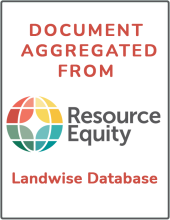Land Library Search
Through our robust search engine, you can search for any item of the over 73,000 highly curated resources in the Land Library.
If you would like to find an overview of what is possible, feel free to peruse the Search Guide.
/ library resources
Showing items 1 through 9 of 118.This case study reviews available literature on the land tenure situation of women in Sierra Leone and analyses the impact of an FAO project in two rural villages in ensuring that women are better able to claim their customary rights to land.
Bhutan is a small, landlocked country deep in the eastern Himalayas between India and China. Over a horizontal distance of just 100-150 km, the elevation rises from about 150 meters above sea level in the south to over 7,000 meters in the north.
Rangelands research in arid and semi-arid sub-Saharan Africa has been reinvigorated by renewed government and donor interest in pastoral livelihoods.
The convoluted nexus between bovine livestock and the dynamics of armed confrontation in Colombia is a terrain open for exploration.
Agriculture is important for Ghana’s economy and the livelihoods of the majority of the rural population even though its level of contribution to GDP is declining.
Drylands occupy more than 40% of the world’s land area and are home to some two billion people. This includes a disproportionate number of the world’s poorest people, who live in degraded and severely degraded landscapes.
Climate services are important in helping smallholder farmers manage climate-related risks and adapt to climate change, especially for rainfed agricultural production systems.
In general, government agricultural extension services were low or inadequate in many communities. Farmers reported not having adequate information on sound farm management practices and when they do come, they come in late. The gendered differences on access to information were also evident.
Many development countries are currently undergoing major demographic shifts as the percentage of young people of the total population rapidly increases. This shift is associated with high rates of migration, unemployment and instability.



